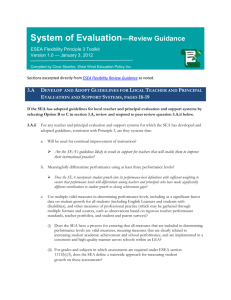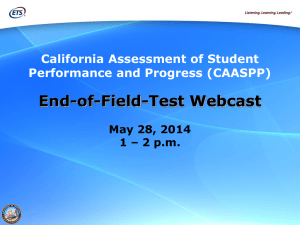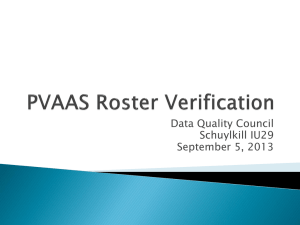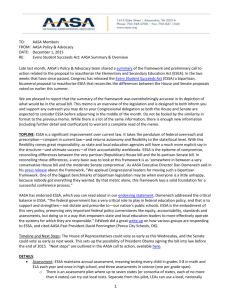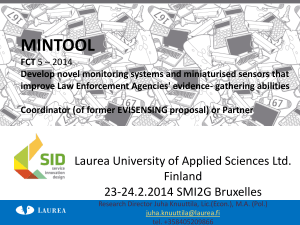Significant Spending fiScal ruleS every Student SucceedS act
advertisement
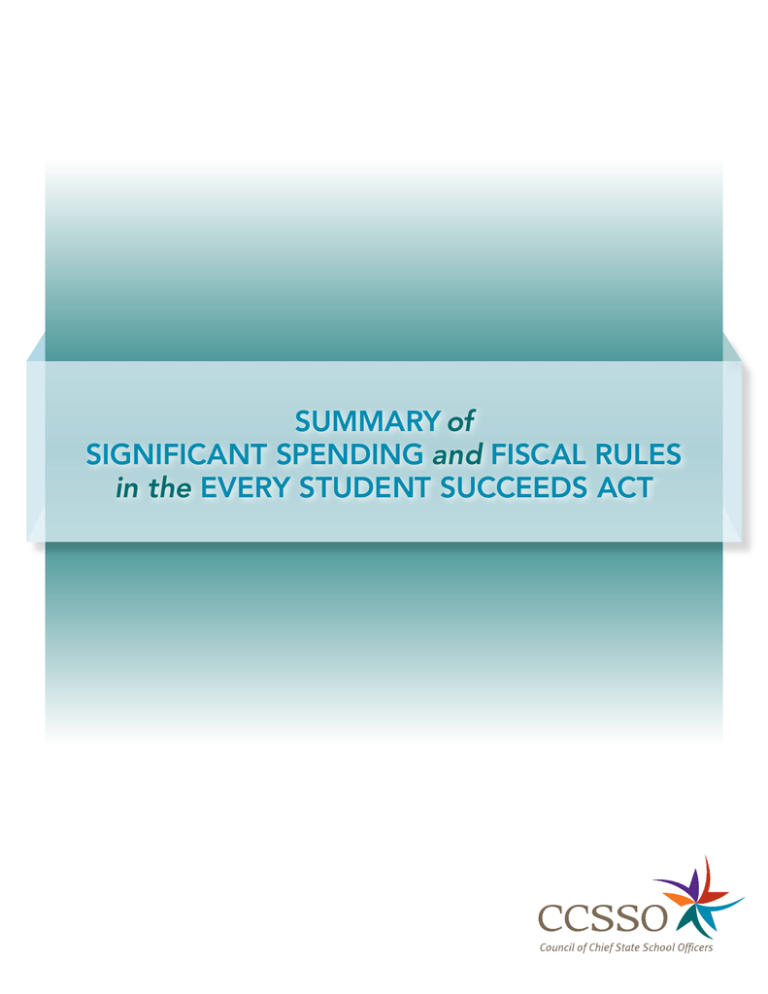
Summary of Significant Spending and Fiscal Rules in the Every Student Succeeds Act The Every Student Succeeds Act (ESSA), which was signed into law on December 10, 2015, makes important changes to the Elementary and Secondary Education Act (ESEA). Most of these changes will not take effect until the 2017-2018 school year. Until then, ESEA grants – including grants awarded in 2016-2017, will be governed by the No Child Left Behind Act (NCLB) (that is, the law in effect before ESSA was enacted) though certain provisions of NCLB, such as the Highly Qualified Teacher requirements and Supplemental Educational Services (SES) and choice are subject to transition provisions and will operate differently in 2016-2017. For more information about ESSA timelines, including descriptions of rules that will and will not apply in 2016-2017, please see these Frequently Asked Questions from the U.S. Department of Education (ED) http://www2.ed.gov/policy/elsec/leg/essa/faq/essa-faqs.pdf. This document provides a plain-language summary of some of the statutory changes to spending and related fiscal rules that will take effect in 2017-2018 under Title I, Part A (including 1003 and 1003A), Title II, Part A, Title III, Part A, Title IV, Part A, and Title VIII (general provisions). It is important to note ED has not yet regulated or issued guidance on these issues; therefore this document only summarizes the statutory text. Because more information from ED is expected in the coming months, this summary should be seen as a starting place to help states, school districts and others identify key changes that will affect future grants. School Improvement: Section 1003 Beginning in 2017-2018, SEAs must reserve 7% of their Title I, Part A grant to support school improvement activities, or an amount that equals what the SEA received in 1003(a) and 1003(g) in 2016-2017, whichever is greater. This is an increase from the 4% required by NCLB, which could help offset ESSA’s elimination of NCLB’s School Improvement Grant (SIG). Beginning with the 2018-2019 grant year, when making the 1003(a) reservation, an SEA may not reduce the amount of Title I, Part A funds any LEA received the prior year. This might limit how much the SEA can reserve under 1003. SEAs must allocate at least 95% of the reserved funds to LEAs to serve schools implementing: • Comprehensive support and improvement activities under 1111(d) (for the lowest performing schools and schools with high dropout rates identified by the SEA), or • Targeted support and improvement activities under 1111(d) (for schools with consistently underperforming subgroups identified by the SEA). Rules on how SEAs may distribute funds, and LEA application requirements, are in section 1003(e)-(f). SEAs must spend the funds they keep at the state level (up to 5%) for: Summary of Significant Spending and Fiscal Rules in the Every Student Succeeds Act Sections 1003/1003A and Title I, Part A 3 • E stablishing a method for allocating funds to LEAs, • Monitoring and evaluating LEA uses of 1003 funds, and • A s appropriate, reducing barriers and providing operational flexibility for identified schools. SEAs must annually report which LEAs and schools received 1003 funds, the amount of funds each school receives, and what strategies they implemented. Direct Student Services: Section 1003A SEAs have a new option to reserve up to 3% of their Title I, Part A allocation to award grants to LEAs to pay for direct student services. The SEA can use up to 1% of the reserved funds for administering the grant program. The SEA must allocate the rest to geographically diverse LEAs, giving priority to LEAs that serve the highest percentage of schools identified for comprehensive or targeted support and improvement. Application requirements are specified in section 1003A(d). LEAs that receive funds may use up to 1% for outreach and communication to parents, and up to 2% for administration. LEAs must use the rest of the grant to pay for direct student services such as academic courses not offered at the student’s school, credit recovery, Advanced Placement/college credit bearing Summary of Significant Spending and Fiscal Rules in the Every Student Succeeds Act classes, personalized learning, and in some cases public school choice transportation. 4 Program Delivery Changes that Affect Spending: Sections 1111, 1114 & 1115 ESSA clarifies that SEAs, LEAs, and schools can take diverse approaches to educational improvement to meet student needs and that Title I funds may be used on a broad array of activities. These policy and programmatic changes include: • Section 1111(c): Accountability systems that incorporate various measures of school success, including student achievement, graduation rates, English proficiency, and at least one indicator of school quality or student success (such as student engagement or school climate), • Section 1114(a)(1)(B): Giving more schools access to the schoolwide program model by permitting SEAs to waive the 40% poverty threshold normally required to operate a schoolwide program, after taking into account how a schoolwide program would best serve the needs of students in that school and improve academic achievement, • Section 1114(b)(7): Expanding the strategies schoolwide program schools can use to address their needs, such as (but not limited to): counseling and mental health programs, mentoring services, access to advanced coursework, student behavioral supports, recruitment and retention activities for teachers, and • Sections 1114(b)(7) & 1115(b)(2): Incorporating the concept of a well-rounded education into both the schoolwide and targeted assistance program models Expenditure Reporting: Section 1111(h) SEAs must annually report: The per-pupil expenditures of federal, state, and local funds, including actual personnel expenditures and actual nonpersonnel expenditures of federal, state, and local funds, disaggregated by source of funds, for each local educational agency and each school in the state for the preceding fiscal year. LEAs must also report this information annually for its spending and spending in each of its schools. Optional Reservation for Public School Choice Transportation: Section 1111(d)(1)(D) LEAs with schools identified for comprehensive support and improvement may, but are not required, to offer students in such schools the right to transfer to another non-identified school. If an LEA offers choice, it may reserve up to 5% of its Title I, Part A allocation to provide transportation. LEA Reservation for Homeless, Neglected, and Delinquent Children: Section 1113(c)(3) As with prior law, before distributing Title I allocations to schools, LEAs must reserve funds as necessary to provide services to homeless students and neglected students that do not attend Title I schools (and if appropriate, children in local institutions for delinquent children, and neglected and delinquent children in community day programs). allowable expenditures or transfers by the LEA. ESSA also clarifies LEAs may determine how much to reserve for homeless children based on a needs assessment (which can be the same needs assessment performed under McKinney-Vento), considering the number of homeless students in the LEA. LEAs can spend the reserved funds for homeless students on services not ordinarily provided to other students including: 1) funding the homeless liaison, and 2) transportation services required under McKinney-Vento. LEA Reservation for Early Childhood Education: Section 1113(c)(5) LEAs may reserve funds to provide early childhood education programs for Title I eligible children. (Please note LEAs could spend Title I funds on preschool under NCLB, but ESSA makes the option more explicit.) Ranking and Serving: Section 1113(a) Ranking and serving is the process LEAs use to allocate Title I funds to eligible schools. In general, ESSA maintains the prior law’s ranking and serving rules, but there are two changes that could make it easier for high schools to access Title I funds. Summary of Significant Spending and Fiscal Rules in the Every Student Succeeds Act ESSA clarifies this reservation must be made based on the total Title I, Part A allocation, prior to any 5 The first change is to what is sometimes called the “75% rule.” LEAs must serve all schools with more than 75% poverty in strict rank order regardless of grade span. (LEAs may, if they choose, serve schools with 75% poverty or less by grade span – for example, serve elementary schools in order of poverty before serving middle or high schools.) LEAs can now lower the 75% threshold to 50% for high schools. The second change affects how LEAs measure poverty in secondary schools. If a majority of secondary schools approve, LEAs can measure poverty in secondary schools based on the poverty levels of the elementary schools that feed into them. (Please note using feeder patterns to measure poverty was previously permitted by ED in its non-regulatory guidance, but ED did not require a majority of secondary schools to approve the measure’s use.) Dual or Concurrent Enrollment Spending Options for Title I schools: Sections 1114(e) & 1115(f) Secondary schools may use Title I funds for the costs of dual or concurrent enrollment programs including training teachers, tuition, fees, books and instructional materials, and transportation. (Please note that in a targeted assistance program services are limited to eligible students with the greatest need for special assistance.) Parent and Family Engagement: Section 1116 As with prior law, LEAs receiving more than $500,000 in Title I funds must reserve 1% of their allocation Summary of Significant Spending and Fiscal Rules in the Every Student Succeeds Act for parent and family engagement, but ESSA clarifies LEAs may reserve more than 1% if they choose. 6 LEAs must allocate 90% of the reserved funds to Title I schools, with priority to high-need schools. This is a change from prior law, which required the LEA to allocate 95% of the reserved funds. The funds reserved for parental involvement must be used to carry out activities and strategies consistent with the LEA’s parental and family engagement policies, including at least one of the following: • Supporting schools and nonprofit organizations in providing professional development on parent and family engagement strategies, • Supporting programs that reach parents and family members at home, in the community, and at school, • Disseminating information on best practices focused on parent and family engagement, especially the engagement of economically disadvantaged parents and family members, • Collaborating, or providing subgrants to schools to enable them to collaborate, with organizations or employers with a record of success in improving and increasing parent and family engagement, or • Engaging in any other activities and strategies the LEA determines are appropriate and consistent with its policy. Equitable Services for Private School Students: Section 1117 As with prior law, LEAs must reserve some of their Title I, Part A funds to provide services to eligible students who attend private schools. ESSA requires LEAs to calculate the reservation based on the total amount of Title I, Part A funds received by the LEA, prior to any allowable expenditures or transfers. LEAs can calculate the equitable share annually or every two years. Funds allocated to an LEA must be obligated in the same fiscal year they are received. SEAs are required to: • Notify “appropriate private school officials in the state” of the amounts LEAs have reserved for equitable services, • Designate an ombudsman to oversee LEA compliance, and • Provide services directly to private schools if the appropriate private school officials so request, and if they have demonstrated the LEA has not met equitable services requirements. Supplement not Supplant: Section 1118(b) As with prior law, SEAs, LEAs and schools must spend Title I funds to supplement and not supplant their state and local education spending. However, ESSA’s method for testing compliance with this requirement is different than prior law. therefore, more information will be forthcoming. But, in general, instead of looking at individual costs to determine if they are supplemental (as is currently done),1 compliance will be tested by looking at the methodology the LEA uses to allocate state and local money to each Title I school. LEAs must show each Title I school receives all the state and local money it would receive if it were not a Title I school. Please note this change applies to LEAs and Title I schools. It is not clear how compliance will be tested for SEA spending. Local Maintenance of Effort: Sections 1118(a) and 8521 As previously required, LEAs must spend at least 90% of the state and local money they spent the prior year on providing a free public education to receive a full Title I allocation. This is known as “maintenance of effort” (MOE). 1 Currently, supplement not supplant compliance is tested by asking a series of questions to determine whether an LEA or school would have paid for the activity if it did not get Title I money. The questions are: Was the state or district using Title I to pay for an activity it was required to do under state, local or other federal law? Was the state or district using Title I to pay for an activity it supported with state or local funds last year? Was the state or district using Title I to pay for an activity to support students who participated in the Title I program while at the same time using state or local money to pay for the same for non-Title I students? While a different, more flexible supplanting rule was supposed to be in place for schoolwide program schools, in practice this was not widely implemented. ED addressed confusion over the schoolwide program’s supplement not supplant requirement in July 2015 guidance: http://www2.ed.gov/policy/elsec/guid/eseatitleiswguidance.pdf. Summary of Significant Spending and Fiscal Rules in the Every Student Succeeds Act The U.S. Department of Education plans to regulate on Title I’s supplement not supplant requirement; 7 ESSA provides some flexibility for when an SEA must reduce an LEA’s Title I allocation due to an MOE violation. An SEA must reduce an LEA’s Title I allocation if it fails to meet its MOE target if the LEA also failed to meet MOE at least once in the prior five years. (In other words, if the LEA met the MOE target in Years 1-5, but not in Year 6, the SEA would not reduce its allocation.) This is more flexibility than in the prior law, which required SEAs to reduce allocations each time an LEA failed MOE. ESSA also permits a change in the LEA’s organizational structure to be grounds for ED to waive MOE. State Maintenance of Effort (MOE) under Education Finance Incentive Grant (EFIG): Section 1125A(e) As with prior law, states must spend at least 90% of the state money they spent the year before on providing a free public education to receive a full EFIG allocation (one of the four grants that make up Title I, Part A). ESSA provides some flexibility for when ED must reduce an SEA’s Title I allocation due to an MOE violation. ED must reduce an SEA’s EFIG allocation if the SEA also failed MOE at least once in the prior five years. (In other words, if the LEA met the MOE target in Years 1-5, but not in Year 6, its allocation would not be reduced.) This is more flexibility than prior law, which required ED to reduce the EFIG allocation each time an SEA failed MOE. Summary of Significant Spending and Fiscal Rules in the Every Student Succeeds Act ESSA also permits a change in the state’s organizational structure to be grounds for ED to waive MOE. 8 Title II, Part A Title II Formula Grants to States: Section 2101(a) ESSA changes the formula for distributing Title II, Part A funds among states. As with prior law, there are two parts to the Title II formula: • A “hold harmless” allocation that guarantees states at least as much money as they received in 2001 under three (no longer authorized) programs related to Title II,2 • An allocation based partly on a state’s number of 5-17 year olds (population levels) and partly on a state’s number of low-income 5-17 year olds (poverty levels). ESSA gradually reduces the “hold harmless” amount between 2017 and 2022 until it is eventually eliminated. ESSA also changes the amounts generated by population versus poverty. Now, states generate 35% based on population and 65% based on poverty. The percentages shift between 2018 and 2020 until it is 20% based on population and 80% based on poverty. To see how this change is projected to affect state allocations, please see this report by CRS https:// assets.documentcloud.org/documents/2644885/ESEA-Title-II-a-State-Grants-Under-Pre.pdf 2 Eisenhower Professional Development, Class Size Reduction, and Staff Assistance. State Uses of Funds: Section 2101(c) Title II, Part A funds are distributed as follows: • SEAs must subgrant 95% of the Title II, Part A allocation to LEAs. o Optional state reservation: From this 95%, SEAs may reserve not more than 3% for activities for principals or school leaders. • SEAs may retain 5% of the Title II, Part A allocation. SEAs may use no more than 1% of the total Title II, Part A allocation for administration, and the remaining funds (4% if the entire 1% is used for administration) must be used for state activities. Permissible state activities have expanded considerably and include: teacher certification reform, evaluation, equitable access to teachers, alternative routes for certification, recruitment and retention, establishing or expanding teacher or school leader academies, appropriate data use, professional development, and others. Title II Subgrants to LEAs: Section 2102(a) ESSA changes the formula for distributing Title II, Part A funds to school districts. Under prior law, LEAs were guaranteed to receive at least as much as they received under certain other programs in 2001 under a “hold harmless” provision. (If an LEA did not exist in 2001, states had to make ESSA eliminates the hold harmless in subgranting funds to LEAs. Now, LEAs generate funds based on their number of 5-17 year olds (20%) and their number of low-income 5-17 year olds (80%). Local Uses of Title II, Part A Funds: Section 2103 ESSA expands, and updates, the list of activities LEAs can carry out with Title II funds. LEAs may carry out these activities through a grant or contract with a for-profit or nonprofit entity, or in partnership with an institution of higher education or tribal organization. Of note are new “evidence based” requirements for using local Title II, Part A funds for class-size reduction and personalized professional development, as well as the role of the SEA in implementing this requirement. Specifically, LEAs can only spend Title II funds on class-size reduction to a “level that is evidence based.” Similarly “personalized professional development” (not all professional development) must be high-quality and “evidence based.” However, for both uses of funds, the evidence-based requirement is to the extent the SEA, in consultation with LEAs, determines that such evidence is reasonably available. Reporting: Section 2104 States must report information about how they spend Title II funds, based in part on information collected from LEAs. Summary of Significant Spending and Fiscal Rules in the Every Student Succeeds Act a series of complicated calculations to determine the LEA’s minimum Title II, Part A grant.) 9 Title III, Part A State Activities: Section 3111(b) As with prior law, SEAs may reserve up to 5% of their Title III, Part A funds for state activities. Permissible state activities include (but are not limited to) establishing statewide entrance and exit procedures, teacher and principal preparation and professional development, planning, technical assistance, and recognition. ESSA changes the amount SEAs may reserve for administration. Of the funds reserved for state activities, SEAs may use 50% or $175,000, whichever is greater, for direct administrative expenses. Under prior law, SEAs could reserve 60% or $175,000 for all administrative costs (direct or indirect). Data for Determining State Allocations: Section 3111(c)(3) As with prior law, ED awards Title III funds to states based on their number of English learners and immigrant children. ESSA clarifies ED must determine a state’s number of English learners using data from the American Community Survey conducted by the Department of Commerce, the number of students being Summary of Significant Spending and Fiscal Rules in the Every Student Succeeds Act assessed for English language proficiency under Title I’s assessment provisions, or a combination of 10 the two. ED must determine a state’s number of immigrant children through the American Community Survey. Local Uses of Funds: Section 3115 Required uses of LEA funds are similar to the prior law, with some additions such as family/community engagement. Authorized uses of funds (that is uses that are permitted, but not required) are also similar with some expansion. As with SEA administration, the LEA’s 2% cap on local administration now only applies to direct administrative expenses. Reporting: Section 3121 Eligible entities that receive subgrants must submit detailed reports every two years on information including activities conducted with Title III, how these activities supplemented state and local programs, and the performance data of children served. The eligible entity and SEA must use the report to improve Title III programs and activities. Title IV, Part A Student Support and Academic Enrichment Grants: Section 4101 ESSA created a new grant program in Title IV, Part A to: • Provide all students access to a well-rounded education, • Improve school conditions for student learning, and • Improve the use of technology to improve the academic achievement and digital literacy of all students. State Formula: Section 4103 Funds are distributed to states based on their relative share of Title I, Part A funds, with a guaranteed minimum for small states. State Uses of Funds: Section 4104 SEAs must subgrant 95% of the Title IV, Part A allocation to LEAs Part A allocation for administration, including reporting, and the remaining funds (4% if the entire 1% is used for administration) must be used for state activities. Permissible state activities include: • Monitoring, training, technical assistance, and capacity building for LEAs, • Identifying and eliminating state barriers to the coordination and integration of programs, initiatives and funding streams that meet the program’s purposes, • Supporting LEAs in providing programs and activities that: o Offer well-rounded educational experiences to all students including certain underrepresented groups, oFoster safe, healthy, supportive, and drug-free environments that support student academic achievement, and oIncrease access to personalized, rigorous learning experiences supported by technology. An SEA that receives funds in FY 2017 may also use state activities funds to pay for accelerated learning exams taken by low-income students in the 2016-2017 school year. Summary of Significant Spending and Fiscal Rules in the Every Student Succeeds Act SEAs may retain 5% of the Title IV, Part A allocation. SEAs may use no more than 1% of the total Title IV, 11 State Allocations to LEAs: Section 4105 LEA allocations are based on their relative share of Title I, Part A funds. LEAs can form consortia and combine their funds. LEA Uses of Funds: Sections 4106(e)(2), 4107-4109 LEAs may reserve up to 2% for direct administrative costs. LEAs that receive $30,000 or more must use: • At least 20% of their allocation on activities to support well-rounded educational opportunities such as (but not limited to) college and career guidance and counseling programs, music and arts programs, STEM subjects, accelerated learning, history, foreign language, environmental education, promoting volunteerism, and other activities to support a well-rounded education. (An LEA that receives funds in fiscal year 2017 may use funds to cover fees for accelerated learning examinations taken by low-income students in school year 2016-2017.) • At least 20% of their allocation on activities to support safe and healthy students such as (but not limited to) drug and violence prevention, school-based mental health services, supporting a healthy, active lifestyle, preventing bullying and harassment, mentoring and Summary of Significant Spending and Fiscal Rules in the Every Student Succeeds Act school counseling, school dropout and reentry programs, and schoolwide positive behavioral 12 interventions and supports. • Some of their allocation on activities to support the effective use of technology such as providing school personnel with professional learning tools, building technological capacity and infrastructure, innovative strategies for delivering specialized or rigorous academic courses through the use of technology, blended learning projects, professional development in the use of technology in STEM subjects, and providing students in rural, remote, and underserved areas with resources to take advantage of high-quality digital learning experiences. Spending on purchasing technology infrastructure is limited to 15% of an LEA’s Title IV, Part A allocation. Supplement not Supplant: Section 4110 All Title IV, Part A funds are subject to a supplement not supplant requirement. Title VIII Definitions: Section 8101 ESSA changes and adds to the definitions section. Spending must be consistent with the requirements in these definitions. State and Local Consolidated Administration: Sections 8201 and 8203 As with prior law, SEAs and LEAs may consolidate the administrative funds they reserve under ESSA programs to support various administrative, oversight, and technical assistance activities. ESSA adds an allowable use of consolidated administrative funds – implementing fiscal support teams that provide technical fiscal support assistance, which includes evaluating fiscal, administrative, and staffing functions, as well as any other key operational functions. In addition, at the LEA level, LEAs may contribute state or local funds to expand the reach of fiscal support teams without violating the supplement not supplant requirements of any contributing program. Equitable Services: Section 8501 As with prior law, LEAs must provide equitable services to eligible private school participants under: • Title I, Part C (Migrant Education), • Title II, Part A (Supporting Effective Instruction), • Title III, Part A (Language Instruction for English learners and Immigrants), • Title IV, Part A (Student Support and Academic Enrichment), and • Title IV, Part B (21st Century Community Learning Centers). educational needs, to the expenditures for participating public school children. Funds allocated to an LEA must be obligated in the same fiscal year they are received. Equitable services under Title II, Part A has changed. Under prior law, LEAs only had to provide equitable services out of any Title II dollars they chose to spend on professional development. Under the new law, there is no specification that the amount spent on equitable services is tied to the amount spent on professional development. As with Title I, the SEA now plays a larger oversight role – the ombudsman designated under Title I must monitor these programs as well, the SEA must notify private schools of the funds available for equitable services, and the SEA must provide direct services if private schools request (and if they demonstrate the LEA has not met requirements). Maintenance of Effort (MOE): Section 8521 As previously required, LEAs must spend at least 90% of the state and local money they spent the prior year on providing a free public education to receive a full allocation under the programs covered by these General Provisions. This is known as “maintenance of effort” (MOE). Consistent with the change to MOE in Title I, ESSA provides some flexibility for when an SEA must reduce an LEA’s allocation due to an MOE violation. An SEA must reduce an LEA’s I allocation if it fails to meet its MOE target if the LEA also failed to meet MOE at least once in the prior five years. (In other Summary of Significant Spending and Fiscal Rules in the Every Student Succeeds Act Expenditures for eligible private school children must be equal, taking into account their number and 13 words, if the LEA met the MOE target in Years 1-5, but not in Year 6, the SEA would not reduce its allocation.) This is more flexibility than in the prior law, which required SEAs to reduce allocations each time an LEA failed MOE. Also consistent with MOE changes to Title I, a change in the LEA’s organizational structure now qualifies as grounds for a waiver of the MOE requirement. Prohibited Uses of Funds: Section 8526 ESSA now prohibits grant recipients from spending ESSA funds on the following activities unless Summary of Significant Spending and Fiscal Rules in the Every Student Succeeds Act specifically authorized in an ESSA program: 14 • School construction, renovation, or repair, or • Transportation. One Massachusetts Avenue, NW, Suite 700 Washington, DC 20001-1431 voice: 202.336.7000 | fax: 202.408.8072
